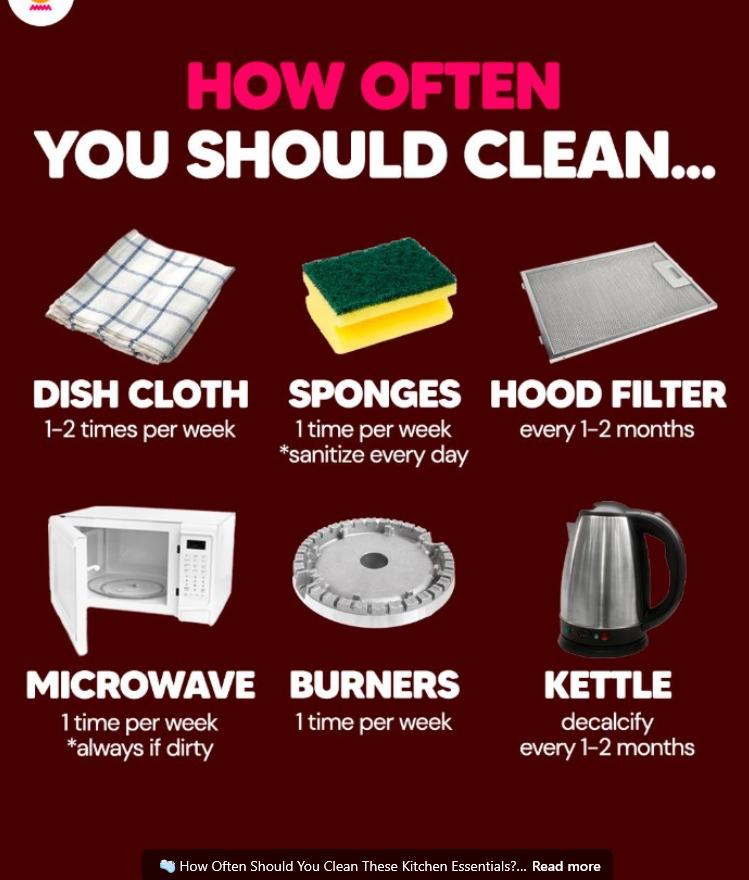ADVERTISEMENT
Sparkle & Sanitize: How Often You Should Really Clean These 10 Common Kitchen Essentials
A clean kitchen is key to maintaining a healthy home, but when it comes to cleaning kitchen essentials, many of us are left wondering: how often should I really be cleaning these items? With the high traffic and frequent use of kitchen tools, it’s easy to overlook the regular cleaning of certain items. However, to ensure a safe and hygienic environment, it’s crucial to give these 10 common kitchen essentials the proper attention and care.
Here’s a guide on how often you should clean these frequently used kitchen items.
1. Cutting Boards
Cutting boards can harbor bacteria, especially after preparing raw meat or chopping fruits and vegetables. If not cleaned properly, they can become a breeding ground for harmful germs.
How often to clean:
- After each use: For basic cleaning, wash your cutting board with hot, soapy water after every use.
- Deep clean: Once a week or after cutting raw meat, sanitize with a mixture of white vinegar and water or a diluted bleach solution. Wooden boards should be oiled regularly to prevent cracking.
2. Kitchen Sponges
Sponges are one of the dirtiest items in your kitchen. They come in contact with everything, from dishes to countertops, and are frequently damp, making them a perfect place for bacteria to thrive.
How often to clean:
- Daily: Rinse your sponge thoroughly after each use to remove food particles.
- Sanitize weekly: You can disinfect your sponge by microwaving it for 1-2 minutes (make sure it’s wet to avoid a fire hazard) or soaking it in a mixture of water and bleach. Replace sponges every 1-2 weeks.
3. Dish Towels
Dish towels absorb moisture and food particles, which can lead to the buildup of bacteria if not cleaned regularly.
How often to clean:
- Every 2-3 days: If you use a dish towel daily, wash it every 2-3 days to avoid cross-contaminating your dishes with germs.
- More often if soiled: Wash immediately if it becomes greasy or has food residue on it.
4. Coffee Makers
Whether you use a drip coffee maker, a French press, or an espresso machine, these appliances accumulate coffee oils and bacteria. Neglecting regular cleaning can result in bitter-tasting coffee and an environment for mold and mildew.
How often to clean:
- Drip coffee makers: Clean once a week. Run a mixture of equal parts water and vinegar through the machine, followed by a few cycles of plain water to rinse.
- French press or espresso machine: Wash with warm soapy water after each use.
5. Refrigerator
A clean fridge helps maintain freshness and keeps bacteria at bay. Spills, spoiled food, and food odors can quickly build up in your refrigerator.
How often to clean:
- Every 1-2 weeks: Wipe down the shelves and drawers with a mild cleaner or a mixture of water and vinegar. This helps prevent spills and odors from lingering.
- Monthly deep clean: Empty the fridge, throw away expired items, and give the interior a more thorough cleaning to remove grime and prevent mold growth.
6. Microwave
Microwaves can accumulate splatters and spills from reheated food. If left uncleaned, these can lead to unpleasant odors and bacteria buildup.
How often to clean:
- Every week: Wipe the microwave’s interior with a damp cloth to remove any food splatters or crumbs.
- Deep clean: Once a month, steam clean by placing a bowl of water with lemon juice inside and microwaving it for a few minutes. The steam will loosen any grime, making it easier to wipe away.
7. Trash Cans
Trash cans are an obvious source of odors and bacteria in the kitchen. If you don’t clean them regularly, they can contribute to unpleasant smells and hygiene issues.
How often to clean:
- Once a week: Wash your trash can inside and out with soap and water. Wipe it with a disinfectant to kill germs.
- More often if necessary: If you have food scraps, esp
